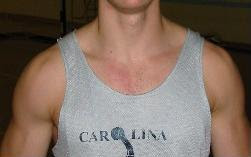When working out chest, I like to again focus on compound exercises. I'll usually start with some variation of the bench press--be it flat, incline, or decline; barbell or dumbells. Incline is my favorite (because it is the hardest), but I'll mix it up. This time, I will start with flat bench and use a technique similar to what I used for squats on leg day. However, this time I will perform a "hold" with more weight than I can actually lift before performing my true working sets. Simply load the bar with 25% more weight than your 1RM and have a spotter help you unrack the weight. Then, hold the weight with arms extended for ten seconds and rack the bar. This "hold" will get your body used to relatively heavy weight, so when you drop back down, the weight will feel really light in your hands. After flat bench press, I'll do another bench press variation, followed by some type of flies (either with the cables or dumbells), and call it a day. In detail, the workout looks like the below:
Flat Barbell Bench Press:
Set 1: 135lbs * 10 reps (warm-up)
Set 2: 225lbs * 8 reps (warm-up)
Set 3: 275lbs * 3 reps to failure
Set 4: 365lbs * "hold"
Set 5: 225lbs * 10 reps to failure
Set 6: 225lbs * 8 reps to failure
Set 7: 225lbs * 6 reps to failure
Incline Barbell Bench Press:
Set 1: 185lbs * 10 reps to failure
Set 2: 205lbs * 4 reps to failure
Set 3: 225lbs * 2 reps to failure
Cable Flies:
3 Sets to Failure in 8-10 rep range
Sometimes, later in the week, I will add some additional chest work (or leg work) where I focus on dynamic lifts with 50%-60% of my 1RM for speed--this practice gets the body used to moving the bar quickly. It will help develop functional strength for your muscle building hypertrophy workouts.
If you want to try this workout for your chest day, simply adjust the weight to what is relatively heavy for you. Also, don't forget to practice good form--it is good practice to have an arch, but keep your butt on the bench and drive the bar up in as straight a line as possible. Grip tightly and try to "pull the bar apart"--that will get more of your triceps involved.
Monday, August 6, 2007
Chest Day
Posted by
J
at
6:37 PM
63
comments
![]()
Wednesday, August 1, 2007
Leg Workout
For leg day, the bread and butter lift is the squat. It is a compound lift that incorporates all of the muscles in the leg (quads, glutes, hip flexors, hamstrings). Therefore, the leg workout should focus around performing squats. I try to go up weight as high as I can, and when I can no longer do full squats, I begin to limit the range of motion. Then, I drop weight and do three working sets to failure with the heaviest weight I can handle and still make full squats with good form. In this manner, my body is used to the very heavy weight from the half and quarter squats, so, at this point, the weight feels very light on my shoulders. After squats, I do deadlifts--another great compound exercise. At that point, my legs are wobbly and I am ready to go home. I know a lot of people like to do leg extensions and leg curls, but I don't feel like they add a tremendous benefit after the compound exercises. Additionally, the machines limit your range of motion as compared to free weights. In detail, the workout looks like the below:
Squat:
Set 1: 135lbs * 10 reps for full squat
Set 2: 225lbs * 10 reps for full squat
Set 3: 315lbs * 10 reps for full squat
Set 4: 405lbs * 5 reps for half squat
Set 5: 495lbs * 2 reps for quarter squat (basically just getting used to the weight)
Set 6: 315lbs * 12 reps for full squat to failure (after 495, the weight feels very light)
Set 7: 315lbs * 10 reps for full squat to failure
Set 8: 315lbs * 8 reps for full squat to failure
Deadlift:
Set 1: 225lbs * 10 reps
Set 2: 275lbs * 10 reps to failure
Set 3: 315lbs * 4 reps to failure
If you want to try this workout for your leg day, simply adjust the weight to what is relatively heavy for you. Also, don't forget to practice good form--squats and deadlifts are the easiest way to injury your back or knees if you don't do them correctly.
Posted by
J
at
4:17 PM
1 comments
![]()

